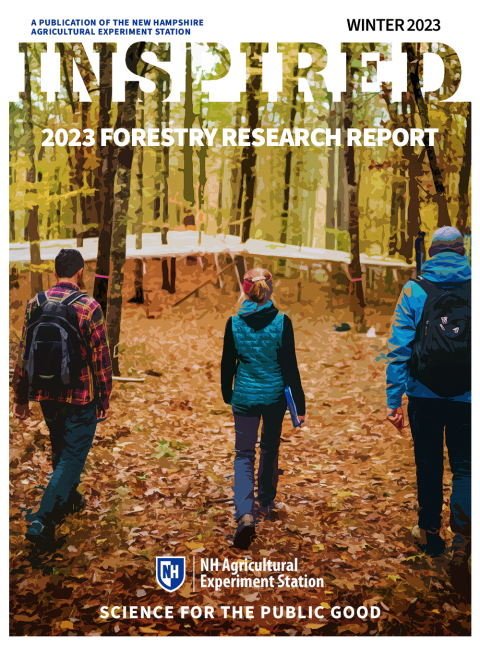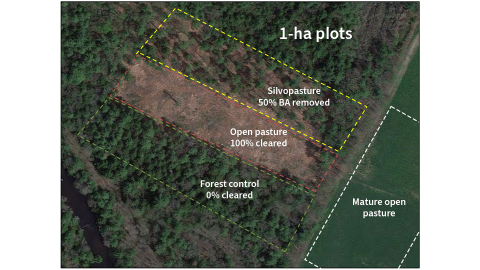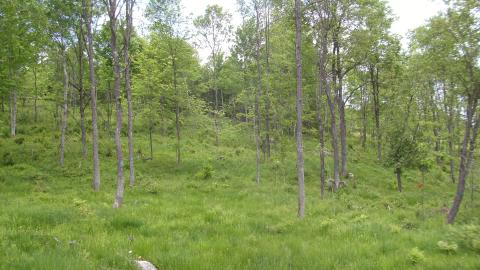Key Findings

Agroforestry systems such as silvopasture and forest farming may offer sustainable food production that aids climate change mitigation and climate adaptation.
Conversion of temperate forests in the northeastern United States to silvopasture results in lower greenhouse gas emissions compared to conversion to open pasture.
Silvopasture was shown to reduce soil greenhouse gas emissions by 35-50 percent, greater soil water dynamics and higher rates of annual tree growth.
About the Co-Author

Heidi Asbjornsen, Professor of Natural Resources and the Environment
Contact information: Heidi.Asbjornsen@unh.edu, UNH Ecohydrology Lab
This research was published in the INSPIRED: A Publication of the New Hampshire Agricultural Experiment Station (Winter 2023)
Researchers: H. Asbjornsen, A. Coble, A. Contosta, K.A. Jennings, J. Orefice, R. Smith, A. Stewart, and M. Vadeboncoeur
The conversion of forests to agricultural land can have negative environmental consequences, such as increasing greenhouse gas emissions and decreasing the land’s resilience to disturbances due to extreme weather events. Agroforestry—the practice of planting trees and other woody plants with crops and/or livestock—may increase the climate mitigation potential of the land and its adaptive capacity. This could especially be the case when compared to conventional ‘open’ systems that normally lack woody plants and have relatively low plant diversity. This study monitored the effects of land-use changes for silviculture on greenhouse gas emissions, carbon storage and water dynamics.
Is agroforestry suitable for New England?
Land use change, especially the conversion of forests to crop or pastureland, reduces carbon storage and increases emissions of greenhouse gases, diminishing the climate change mitigation potential of forested ecosystems. Moreover, the relatively low diversity and intensive management of most conventional agricultural systems can lead to adverse environmental impacts and lower resilience to disturbances, such as extreme weather or pest or pathogen outbreaks.
Land cover in the Northeast has changed several times over the past few centuries. The region experienced widespread forest clearing in the 18th century by European settlers, followed by farm abandonment in the mid-19th century and subsequent secondary forest regrowth. More recently, forest loss has occurred due to urban and suburban expansion. Less widely recognized has been the potential loss of forestlands to agriculture in response to a resurgence in demand for locally grown food. Additionally, population growth, economic development and climate change may further the trend of forest-to-agriculture conversion.
If such conversions continue to happen to the region's forestland—currently 60-80 percent of the total area—agroforestry could be a sustainable strategy. Agroforestry—which retains more trees and ecological functions within food production systems—can help mitigate the negative consequences of forest-to-agriculture conversion. For example, trees sequester and store more carbon than herbaceous plants and their extensive root systems contribute to nutrient cycling, soil stability and erosion control. Because trees take up more water than crops, they can also increase the water storage capacity of soil, which is important for regulating hydrologic flows and reducing flood risk.
Additionally, integrated agroforestry systems can have much higher biodiversity compared to typical agroecosystems. This biodiversity may confer greater resilience to disturbances and more stable productivity. Tree cover also provides shade that helps to stabilize microclimates, which can be important for both animal health and grass productivity during periods of high heat and low moisture common in late summers.
The Northeast is expected to experience more total, variable and extreme rainfall, and agricultural systems that offer both high carbon storage and hydrologic regulation services are critical to climate adaptation. But while previous research on agroforestry focused on tropical regions, knowledge of temperate agroforestry systems—such as those in the Northeast—is nascent.
Measuring conversion of forests to silvopasture
One of the dominant agricultural practices in New England is the production of dairy and meat from cattle, which are often grazed on open fields. Silvopasture—the deliberate integration of trees, forages and livestock on grazed land—may offer a more climate sustainable alternative. Past research has assessed the climate benefits of incorporating trees into cultivated or grazed systems, but less work has been conducted into how removing trees affects greenhouse gas fluxes—the rate of exchange of gasses between the Earth’s surface and the atmosphere—especially in the northeastern U.S. where such practices are relatively recent.
This research quantified the effects of converting forests to silvopasture—relative to converting forests to open pasture—on carbon dioxide (CO2) and nitrous oxide (N2O) emissions of the soil, retention of carbon and nitrogen in the soil and microclimate conditions. The work also assessed the response of silvopasture, open pasture and closed canopy forest ecosystems to an extreme drought that occurred in 2016.
A land-use change experiment was conducted at the University of New Hampshire’s Organic Dairy Research Farm (ODRF) located in Lee, NH, and collected measurements at a second similar experiment at the North Branch Farm in Saranac, NY. Both experiments involved converting forest plots to either open pasture or silvopasture by removing all or a portion of the trees, and then comparing the response to these treatments with the conditions in un-manipulated reference forest and reference open pasture plots.
Measurements were collected over a 4-year period to assess meteorological conditions, such as air temperature, soil temperature and soil moisture, and soil greenhouse gas emissions. Carbon and water cycling were determined using tree growth (an indicator of carbon sequestration and storage) by collecting cores and measuring tree ring width and radial growth three years before and after the treatment.
Estimates of both inputs and outputs were used to quantify the effects of forest conversion on water balance. The primary input of water was throughfall—the amount of rainfall that reaches the soil surface because it is not intercepted by trees. The primary output of water was considered evapotranspiration—the process by which water is transferred from the land to the atmosphere by evaporation from the soil and other surfaces and by transpiration from plants. This was calculated through a combination of direct measurements and modeling. Additionally, soil infiltration rates were determined for all treatment and reference plots to provide an indication of the effects of forest conversion on hydrologic functions, such as soil water storage capacity and flood control.

Total CO2 flux from the treatment plots in response to forest conversion to silvopasture or open pasture at the UNH Organic Dairy Research Farm in Lee, NH and the North Branch Farm in Saranac, NY.
A direction for climate resilient farming
Results from this study indicate that soil greenhouse gas emissions were generally lowest in the reference forests, higher in converted and reference open pastures and intermediate in silvopastures (Fig. 2). At the ODRF, growing season soil carbon dioxide emissions from the reference open pasture were approximately 50 percent greater than the other land use treatments, while emissions from the silvopasture were more similar to the reference forest. At North Branch Farm, soil carbon dioxide losses were 35-55 percent higher in the converted open pasture when compared to the other treatments, and the converted silvopastures exhibited intermediate values.
Similar patterns were observed in greenhouse gas emissions from the soil, including nitrous oxide that is 300 times as powerful as carbon dioxide at trapping heat in the atmosphere. Warmer air and soil temperatures and higher soil moisture availability recorded in both reference and converted open pastures likely contributed to higher greenhouse gas emissions exhibited by the open pastures.
Study results showed that silvopasture trees had higher rates of annual tree growth compared to the trees growing in the reference forest, especially for red oak and eastern hemlock, even during the drought year (2016). This suggests that lower tree densities in silvopasture may enhance resilience to water stress.
Water use by trees was significantly greater in white pine and red oak in the silvopasture compared to the reference forest during the drought year, also indicating higher drought resilience.
Related published research
- Agriculture, Ecosystems & Environment: Climate consequences of conversion of forest-to-pasture or -forest-to silvopasture within the New England region
- Agriculture, Ecosystems & Environment: Influence of forest-to-silvopasture conversion and drought on components of evapotranspiration.
- Agroforestry Systems: Soil and understory plant dynamics during conversion of forest to silvopasture, open pasture, and woodlot
- Agroforestry Systems: Forage productivity and profitability in newly-established open pasture, silvopasture, and thinned forest production systems
- Agroforestry Systems: Forest conversion to silvopasture and open pasture: effects on soil hydraulic properties
Total evapotranspiration in silvopasture was intermediate between forest (35 percent lower) and pasture (57 percent higher), which is consistent with silvopasture maintaining higher hydrologic regulation services compared to open pasture. Differences in soil infiltration rates across treatments also demonstrated the water storage potential of agroforestry systems. Overall, silvopasture had higher soil infiltration rates than open pasture, and these rates were more similar to conditions in the reference forest.
These results highlight the potential for silvopasture to ameliorate the negative climate consequences of forest clearing for agriculture in the northeastern U.S. and other temperate forested regions worldwide, offering a promising climate-resilient and environmentally sustainable food production system in New England.
This material is based on work supported by the NH Agricultural Experiment Station through joint funding from the USDA National Institute of Food and Agriculture (under Hatch award number 1022415) and the state of New Hampshire. Co-authors include H. Asbjornsen, A. Coble, A. Contosta, K.A. Jennings, J. Orefice, R. Smith, A. Stewart, and M. Vadeboncoeur.












